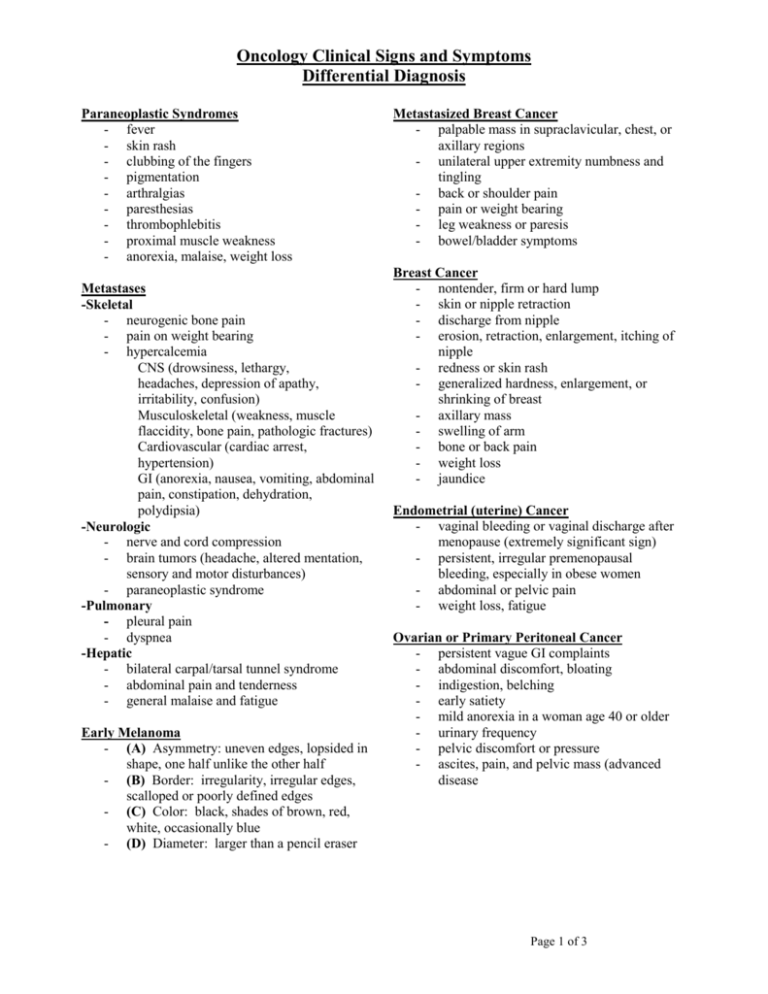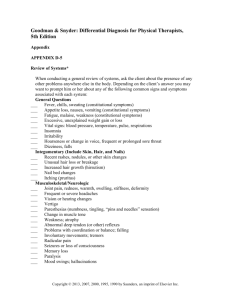Oncology
advertisement

Oncology Clinical Signs and Symptoms Differential Diagnosis Paraneoplastic Syndromes - fever - skin rash - clubbing of the fingers - pigmentation - arthralgias - paresthesias - thrombophlebitis - proximal muscle weakness - anorexia, malaise, weight loss Metastases -Skeletal - neurogenic bone pain - pain on weight bearing - hypercalcemia CNS (drowsiness, lethargy, headaches, depression of apathy, irritability, confusion) Musculoskeletal (weakness, muscle flaccidity, bone pain, pathologic fractures) Cardiovascular (cardiac arrest, hypertension) GI (anorexia, nausea, vomiting, abdominal pain, constipation, dehydration, polydipsia) -Neurologic - nerve and cord compression - brain tumors (headache, altered mentation, sensory and motor disturbances) - paraneoplastic syndrome -Pulmonary - pleural pain - dyspnea -Hepatic - bilateral carpal/tarsal tunnel syndrome - abdominal pain and tenderness - general malaise and fatigue Early Melanoma - (A) Asymmetry: uneven edges, lopsided in shape, one half unlike the other half - (B) Border: irregularity, irregular edges, scalloped or poorly defined edges - (C) Color: black, shades of brown, red, white, occasionally blue - (D) Diameter: larger than a pencil eraser Metastasized Breast Cancer - palpable mass in supraclavicular, chest, or axillary regions - unilateral upper extremity numbness and tingling - back or shoulder pain - pain or weight bearing - leg weakness or paresis - bowel/bladder symptoms Breast Cancer - nontender, firm or hard lump - skin or nipple retraction - discharge from nipple - erosion, retraction, enlargement, itching of nipple - redness or skin rash - generalized hardness, enlargement, or shrinking of breast - axillary mass - swelling of arm - bone or back pain - weight loss - jaundice Endometrial (uterine) Cancer - vaginal bleeding or vaginal discharge after menopause (extremely significant sign) - persistent, irregular premenopausal bleeding, especially in obese women - abdominal or pelvic pain - weight loss, fatigue Ovarian or Primary Peritoneal Cancer - persistent vague GI complaints - abdominal discomfort, bloating - indigestion, belching - early satiety - mild anorexia in a woman age 40 or older - urinary frequency - pelvic discomfort or pressure - ascites, pain, and pelvic mass (advanced disease Page 1 of 3 Acute and Chronic Leukemias - abnormal bleeding - easy bruising of the skin - petechiae - epistaxis (nosebleeds) and / or bleeding gums - hematuria (blood in the urine) - rectal bleeding - infections, fever - weakness - easy fatigability - enlarged lymph nodes - bone and joint pain - weight loss - loss of appetite - pain or enlargement in the left upper abdomen (enlarged spleen) Multiple Myeloma - recurrent bacterial infections (especially pneumococcal pneumonias) - anemia with weakness and fatigue - bleeding tendencies - Bone destruction - skeletal/bone pain (especially pelvis, spine and ribs) - spontaneous fracture - osteoporosis -hypercalcemia (confusion, increased urination, loss of appetite, abdominal pain, vomiting, and constipation - Renal Involvement - kidney stones - renal insufficiency - Neurologic abnormalities - carpal tunnel syndrome - back pain with radicular symptoms spinal cord compression (motor or sensory loss, bowel/bladder dysfunction, paraplegia) Hodgkin’s Disease - painless, progressive enlargement of unilateral lymph nodes, often in the neck - pruritus (itching) over entire body - unexplained fevers, night sweats - anorexia and weight loss - anemia, fatigue, malaise - jaundice - edema - nonproductive cough, dyspnea, chest pain, cyanosis - nerve root pain - paraplegia Non-Hodgkin’s Lymphoma - enlarged lymph nodes - fever - night sweats - weight loss - bleeding infection - red skin and generalized itching of unknown origin AIDS- NHL - painless, enlarged mass - subcutaneous nodules - constitutional symptoms (fever, night sweats, weight loss) - musculoskeletal lesions (lytic bone, pain, swelling) Soft Tissue Sarcoma - persistent swelling or lump in a muscle (most common finding) - pain - pathologic fracture - local swelling - warmth of overlying skin Osteosarcoma - pain and swelling of the involved body part - loss of motion and functional movement of adjacent joints - tender lump - pathologic fracture - occasional weight loss - malaise - fatigue Ewing’s Sarcoma - increasing and persistent pain - increasing and persistent swelling over a bone (localized over the area of tumor) - decrease in movement if a limb bone is involved - fever - fatigue - weight loss Chondrosarcoma - back or thigh pain - sciatica - bladder symptoms - unilateral edema Page 2 of 3 Brain Tumors - Increased intracranial pressure headache, especially retro orbital nausea and vomiting visual changes (blurring, blind spots, diplopia) - Changes in mentation difficulty concentrating (e.g., reading) memory loss personality change, irritability increased sleeping - Seizures (without previous history) - Sensory changes - Muscle weakness or hemiparesis - Bladder dysfunction - Increased lower extremity reflexes compared with upper extremity reflexes - Decreased coordination, ataxia - Positive Babinski reflex - Clonus (ankle or wrist) Spinal Cord Tumors - pain - decreased sensation - spastic muscle weakness - progressive muscle weakness - muscle atrophy - paraplegia or quadriplegia - thoracolumbar pain - unilateral groin or leg pain - pain at rest and/or night pain - bowel/bladder dysfunction (late finding) FROM: DIFFERENTIAL DIAGNOSIS IN PHYSICAL THERAPY, GOODMAN AND SNYDER, 3rd edition. Clues to Screening for Cancer - - - - - - Age older than 50 years Previous personal history of any cancer, especially in the presence of carpal tunnel symptoms, back pain, shoulder pain, or joint pain of unknown or rheumatic cause at presentation Any woman with chest, breast, axillary, or shoulder pain of unknown cause Anyone with back, pelvic, groin, or hip pain accompanied by vague abdominal complaints, palpable mass For women: Prolonged or excessive menstrual bleeding (or in the case of the postmenopausal woman who is not taking hormone replacement, breakthrough bleeding) For men: Additional presence of sciatica and past history of prostate cancer When a back “injury” is not improving as expected or if symptoms are increasing Early warning signs, including proximal muscle weakness and changes in deep tendon reflexes Recent weight loss of 10 pounds or more within 1 month (weight gain is more typical with true musculoskeletal dysfunction because pain has limited physical activities) Constant pain (unrelieved by rest or change in position) Pain present at night Signs of nerve root compression must be screened for cancer as a possible cause Development of new neurologic deficits (e.g., weakness, sensory loss, reflex change, bowel or bladder dysfunction) Changes in size, shape, tenderness, and consistency of lymph nodes, especially painless, hard, rubbery lymph nodes present in more than one location and occurring for more than 4 weeks Page 3 of 3










